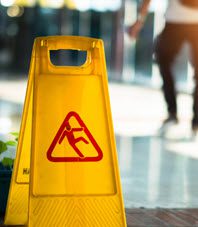Each year in America, about eight million victims are rushed to the hospital emergency room after a serious slip and fall. The elderly are particularly at risk for serious injury, because a majority of these individuals are never able to live independently again after a fall injury.
Under Florida law, property owners are usually responsible for damages in these cases. Such damages include money for tangible losses, such as medical bills, as well as intangible losses, such as emotional distress.
Legal Responsibility
The Sunshine State, like many other jurisdictions, uses a variation of a very old common law classification system. This system has been used for years in America, England, and many other common law countries throughout the world, so it is rather easy to communicate to jurors, despite its apparent complexity. There are basically three categories:
- Invitees: Owners owe a duty of reasonable care to persons who they directly or indirectly invite onto the property and whose presence creates an economic or noneconomic benefit for the owner. Additionally, if the victim is an invitee, the owner also has a duty to inspect the premises and reasonably ensure their safety.
- Licensees: Some victims, such as guests of apartment tenants, have permission on the land but do not convey a benefit to the owner. In these cases, the owner has a duty to warn potential victims about latent defects, such as a burned-out security light.
- Trespassers: In most cases, if the victim did not have permission to be on the property, the owner owes essentially no legal duty. The two biggest exceptions are the attractive nuisance doctrine, which applies to child trespassers, and the frequent trespasser doctrine, which applies if the owner knew that people would probably trespass on the property.
Statute law always trumps common law, and in some cases, Florida lawmakers have modified this scheme. For example, rural landowners may not always be liable under the frequent trespasser doctrine if they open their land for recreational use and people are injured thereon.
Proving Knowledge
Establishing a legal duty is the first step towards recovery, and establishing knowledge of the defect is the second step. Sometimes, there is a restroom cleaning report or another “smoking gun,” providing the victim/plaintiff with direct evidence of knowledge. But in other cases, the victim/plaintiff must use circumstantial evidence and the constructive knowledge (should have known) doctrine.
Anjou v. Boston Elevated Railway Company established the rule for circumstantial evidence cases. In this classic law school case, the victim slipped on a banana peel in a crowded Boston train terminal. Importantly, the witnesses consistently testified that the offending peel was black and gritty as if it had been on the floor for a long time.
Although the railroad company denied knowledge of the offending peel, the court ruled in the victim/plaintiff’s favor, because of the amount of time that the defect had existed. The same basic outline still applies all these years later:
- Black Peel: In the case of a long-lasting hazard, the owner has violated the duty to inspect the premises and keep them reasonably safe for invitees. In other words, constructive knowledge attaches.
- Brown Peel: Sometimes, more evidence is needed to determine the owner’s liability, and that’s the case if the banana peel was brown as opposed to black.
- Yellow Peel: Constructive knowledge does not attach if the hazard only recently appeared, because although the owner has a duty to frequently inspect the premises, the owner does not have the duty to perform constant inspections.
The same analysis applies to other property defects, such as wet spots on the floor or broken gate latches.
Connect with Experienced Attorneys
Property owners are usually liable for injuries that occur on their premises. For a free consultation with an experienced personal injury lawyer in Brandon, contact Reed & Reed.
From our office in Brandon, Reed & Reed helps clients in Tampa, New Tampa, Plant City, East Hillsborough County and throughout the state of Florida.
Resource:
leg.state.fl.us/Statutes/index.cfm?App_mode=Display_Statute&URL=0700-0799/0768/Sections/0768.0755.html




